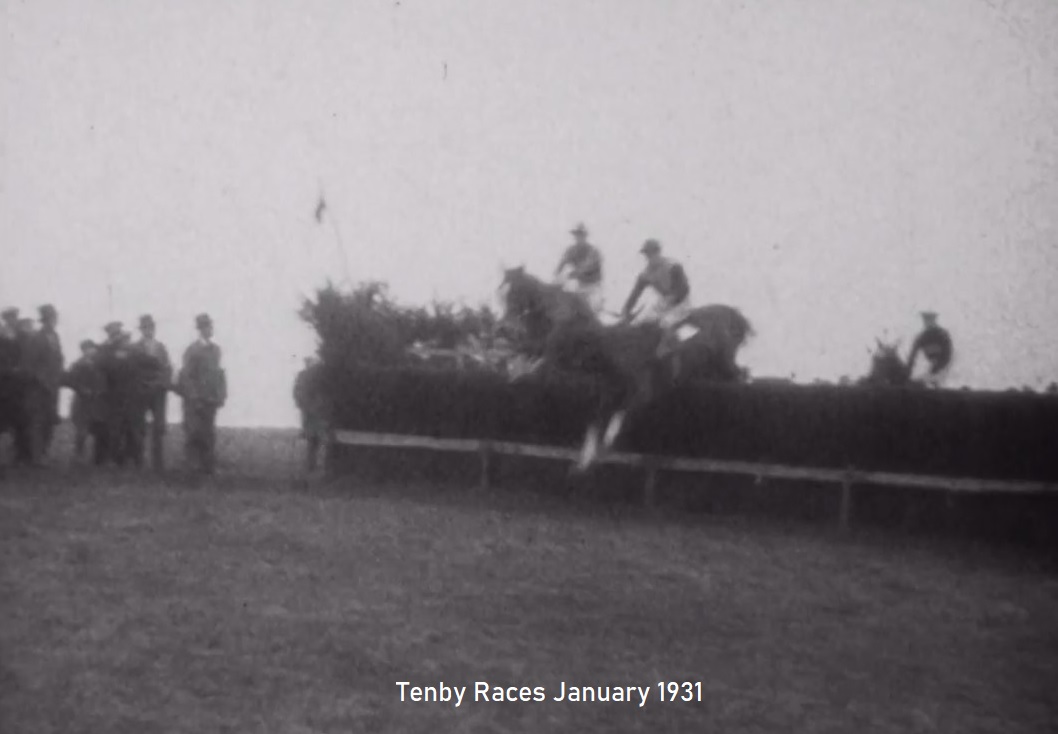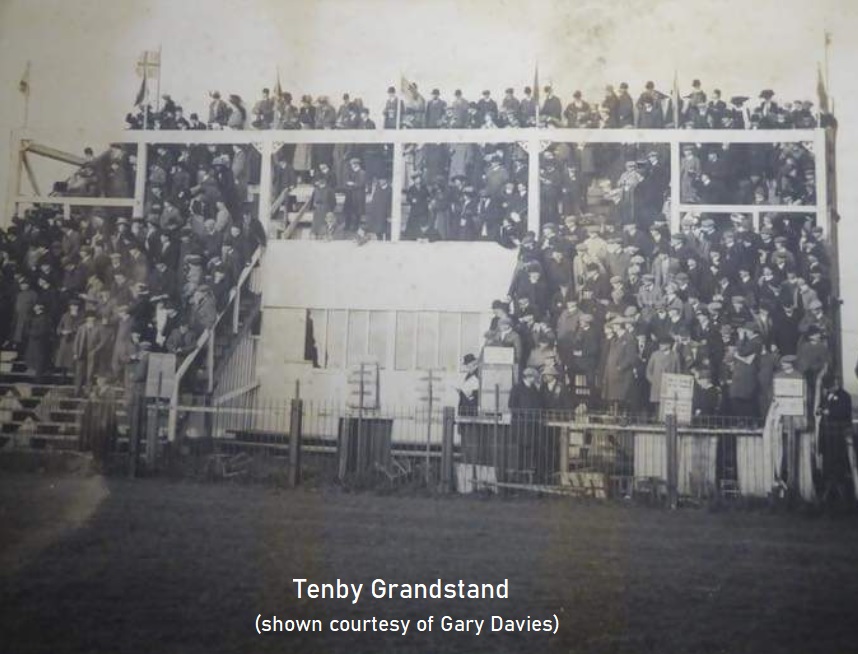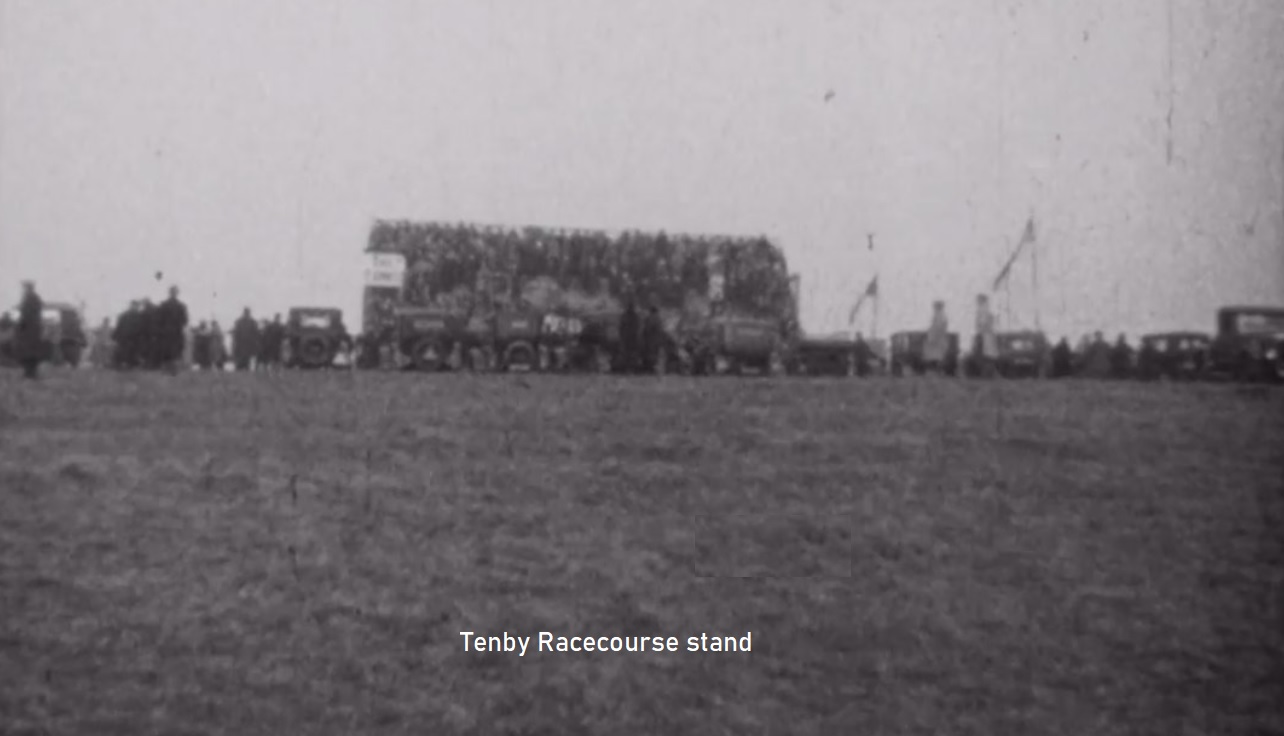Earliest meeting: Wednesday 25th August 1847
Final meeting: Thursday 29th October 1936
The first meeting to take place in the Pembrokeshire town of Tenby was on Wednesday 25th August 1847 when the two day affair began with the Corporation Plate over 2 miles which went to Mr Henderson’s Lady Charlotte. The course was grassland to the west of the town and the programme contained a hurdle race, won by Mr Protheroe’s Chance, a Ladies Cup won by Mr Hendersons’ Susan, and the Stewards Plate won by Mr Bullin’s Faith. Flat racing continued in the town, generally each September, on a course situated at Marsh Road off the Narbeth Road until 1870 after which racing ceased for five years. In 1875 steeplechase meetings were launched in the town on Lodge Farm at New Hedges, and later meetings were transferred to a course near Knightston Farm where a grandstand was erected in time for the 1893 meetings. The mile and a half right-handed course had a run-in of 350 yards and consisted of banks and seven gorse fences as well as a water jump. Meetings ceased during the War years, but returned on Wednesday 14th and Thursday 15th January 1920. However, it was a humble race on Thursday 13th January 1927 which made Tenby headline news and caused the tracks ultimate demise. The newspaper racing expert Eric Graham set the scene,’ David Harrison made a living out of riding, training and betting on horses he kept at stables in the quaintly named Upper Frog Street, exercising his horses on the nearby sands. He was always after landing a touch, and at the meeting on Thursday 13 January 1927 he organised a ‘coup’. The event was the lowly Licensed Victuallers Handicap Hurdle for which there were eight runners, three of whom were trained by David Harrison: Oyster Maid a four-year-old with Billy Stott in the plate; Bubbly ridden by F Rees and Fairy Light owned by Harrison and ridden by Tom Duggan. The bookies shouted 'I'll take 5/2 Bubbly' as the betting opened, a price that was swiftly taken, causing the other runners to drift. Stable mate Oyster Maid was initially chalked up at 10/1 but was unwanted at that price and it soon became 100/8, then 100/6. It was not a great 'seeing' afternoon with blustery winds, sweeping rain and snow over the course, but punters could see that at half way Bubbly took up the running to the cheers of those who had laid the odds, although Oyster Maid was seen to be in close attendance and the pair drew clear. Coming to the last Oyster Maid drew ahead and won by five lengths at the rewarding odds of 100/6, much to the celebration of on-course bookmakers. Not so the off course bookies, where Oyster Maid had been backed minutes before the off and there was no facility for them to send the money back to the track. It was rumoured that one Tenby publican had won £60,000 and that the bookmakers had lost £120,000, in buying power that would be over £6 million in today’s terms. Tenby never did recover from the affair because bookmakers were reluctant to attend future meetings, and off course bookies were wary of taking any future bets from Tenby. The final two day meeting was held on Wednesday 28th and Thursday 29th October 1936.
Tenby Handicap, Principality Stakes, Cresselly Steeplechase, Licensed Victuallers Selling Hurdle (notorious for the incident shown below)
Thursday 27th & Friday 28th September 1866
The Tenby Handicap over 2 miles
1. Dick Turpin owned by Mr Windsor
2. Duchess of St Albans owned by Mr Charles
3. Zephyr owned by Mr C Noble
The Tenby Free Handicap over 1 ½ miles
1. Mountain Maid owned by Mr Windsor
2. Lady Bird owned by Mr Hitchings
3. Overton owned by Mr F C Morgan
The Principality Stakes over 2 miles
1. Lady Bird owned by Mr Hitchings
2. Isle of Man owned by Mr F C Morgan
3. Zephyr owned by Mr C Noble
Thursday 13th January 1927
Licensed Victuallers Handicap Hurdle
1. Oyster Maid, owned by Mr B Warner, trained by D.Harrison, ridden by Billy Stott
2. Bubbly, ridden by F Rees
3. Orange Plume, ridden by Mr P Dennis
I am grateful to Merlyn Edwards (Merlyn Edwards @allmanbros2) for the photos shown here. His Twitter feed on horse racing, especially closed racecourses, is well worth visiting on a regular basis.
The photos are from a meeting held at Tenby in January 1931, but which Steeplechase is shown? The results of all chases at the 2-day meeting are given below.

Wednesday 7th January 1931
Lawrenny Steeplechase over 3 miles
1. BATH CHAP (7/1) owned and ridden by Sir G Cosgreve
Finished alone
Grove Optional Selling Chase over 2 miles
1. HEARTBURN (4/6 fav) owned by Lord Allendale, trained by R Gordon and ridden by J Hamey
2. HACKDENE (6/4) owned by Mrs L Wilson and ridden by D Williams
Only 2 finished

Thursday 8th January 1931
Park House Selling Handicap Chase over 2 miles
1. EASTER BOY II (evens fav) owned and ridden by Mr R E Morel
2. LEWIS GUN (5/4) owned by Mr O A Greenslade and ridden by Gerry Wilson
3. BETTING TAX (8/1) owned by Mr D Heneage and ridden by W Parvin
Town Handicap Steeplechase over 3 miles
1. GEORGINATOWN (1/5 fav) owned by Mr J H Wallace and ridden by F Maxwell
2. CAIRBRE (3/1) owned by Colonel M Lindsay and ridden by Fulke Walwyn

With very grateful thanks to Eric Graham for this article.
Tenby and the Oyster Maid Affair
Where do you draw the line between sharp practice and a genuine coup? A 'stroke' as our Irish friends would have it.
I think we can all agree that cutting telephone wires is out. Apart from being criminal damage it could cause great harm if there were an emergency. Doping is beyond words, in fact any harm to the horses is beneath contempt, after all it is not their decision to be at the races.
Something along the Gay Future line though? A 'dark' horse genuinely winning and fetching the bookmakers what one of the organisers called 'A right sickener'. Sadly for all those who thought up the scheme they happened to pick on an Englishman to be involved in the coup and he messed it up. Messed it up to the extent that the bookmakers did not pay out and a trial ensued. Had the two 'non-runners' been put in a horse-box and driven out of the yard, to anywhere, the cash would have been paid out and a high court judge not have had his knowledge of racing considerably improved. The man in the wig seemed to get on rather well with the defendants incidentally.
So let’s come to poor departed Tenby. Departed from the calendar that is.
It was never a course that drew large fields. Looking through the returns fields of half a dozen or less were the norm. There was a good collection of selling hurdles and chases at the two day annual fixture and it was decidedly 'modest' in character. It was kept going by the generosity and hard work of George Lort Stokes.
George Stokes was very much a man of his times. He had ridden as a gentleman rider at many of the 'Hunt' meetings in Wales. Born in Tenby in 1876 he was a solicitor and had a wide ranging practice at Stokes and Stokes who had offices in Belle Vue Chambers in Tenby. As a public servant he was Town Clerk from 1914. Town Clerk was a much envied position which carried great respect in the time before Local Government became the lavish, costly, mess that it is today.
David Harrison, on the other hand, born just a year before Stokes was a sort of poor man's James Machell. He lived on his wits. From the time he left his birthplace of Staleybridge he made a living out of riding, training and betting on horses. It was a living that lasted just about up to the outbreak of the Second World War. At the time with which we are concerned he had stables in the quaintly named Upper Frog Street and trained a good deal on the nearby sands.
The 'Coup' took place at the meeting on Thursday 13 January 1927. The event was The Licensed Victuallers Handicap Hurdle for which there were eight runners three of whom were trained by David Harrison: Oyster Maid a four-year-old, Billy Stott in the plate, Bubbly, F Rees and Fairy Light owned by Harrison and ridden by Tom Duggan. Bubbly had run no less than 23 times the previous season winning four modest races.
Other runners were the ex-Irish Paddy Milestone, who had the assistance of Joe Canty when in Ireland. Sir J Grey's Any Excuse, in the eye catching blue, gold hoops on body and black cap. Baalbek, Cheekily and Orange Plume made up the field.
The bookies shouted 'I'll take two ponies Bubbly' as the betting opened, a price that was swiftly taken and shortly you would have to lay 50 to 20 on if you fancied the favourite. The other runners were on the drift. Unwanted was Oyster Maid and the chalked up opening 10/1 soon became 100/8, then 100/6. you could have had 20/1 for asking but nobody was. One man did back 'The Maid' on course, Harold Sandercock, but his modest five shillings at 100/6 was hardly likely to move the market.
It was not a great 'seeing' afternoon with blustery winds sweeping rain and snow over the course, but good enough. At half way Bubbly took up the running to the cheers of the punters but Oyster Maid was seen to be in close attendance and the pair drew clear. Turning in it was evens each of two, but coming to the last Oyster Maid drew ahead and won by five lengths. 100/6 the winner, 5/2on the second both from the same stable. But seeing that no-one had backed the winner, apart from Harold, it was just one of those things that happened in racing.
BUT OYSTER MAID HAD BEEN BACKED. The SP offices in the minutes before the off received a rush of business for Oyster Maid and the phone bookmakers had also been hit. The problem was that there was, as in the Gay Future coup, no way of contacting the course to 'lay off' the money. The course did not have a phone. It is said the nearest phone was half a mile away at Bryn Hir where a tic-tac man was stationed to relay any urgent message to the ring. In fact it would have taken Admiral Rous's telescope to see the white gloves of the tic-tac as Bryn Hir was considerably further away than four furlongs and the weather was hardly in a co-operative mood.
How much was taken from the bookmakers? There were large tales told at the time of the money won and these tales have grown over the years. In the eighties it was said a publican, the same publican that appears in all these stories no doubt, won some "£60 - £70,000 on the race". The absurdity of the bookies allowing £4,000 credit on a 'no limit' basis to one man, on an obscure race, on a quiet day in January! It wouldn't happen now, and it couldn't happen then. It may have cost the books £10 - £12,000 in total. Not a bad sum in 1927. In buying power that would be half a million in today's terms, not bad at all.
David Harrison found that 'The Maid' was just that bit ahead on ability and that's all you need, if you have the skill. The filly was partly owned by a professional backer, Ben Warner, who knew how to get the money on and no doubt he and his contacts had a good 'touch'.
You cannot defame the dead, in legal terms that is. Some people should be heartily ashamed of themselves for the stories that were, and are circulated about the people involved. Firstly 'The Affair' was said to be arranged to benefit George Lort Stokes who 'had fallen on hard times'. Hardly, the practice was ticking over nicely. Two amateur riders were said to have been stopped on the far side of the course during a blinding snowstorm during the race, and all the riders were paid 'odds to £50 the winner for their co-operation'. Apart from the fact that seeing foul riding during a 'blinding' snowstorm seems odd, it’s odder that they had to be 'stopped' if they had been promised £800 each.
The stewards were also said, in the same piece, to be on at the same terms and so too the SP man who returned Oyster Maid at 100/6 instead of the 8/1 that was the ring price. It is absurd is it not? We have a conspiracy of at least 15 people, not including the publican. Why not include the starter, Prince Edward and the Bishop of St Davids?
So racing stories go. My grandfather said to me when I was little "You know the first rule in bookmaking Eggie? If two people know something it’s not a secret". So forget the vast conspiracy theories, forget the immense winnings. This was a nice little stroke pulled by a few of the clever people who no doubt enjoyed their winnings and perhaps handed most of the money back to the books before the Lincoln was run.
George Lort Stokes died a few years after Tenby Racecourse's famous day. Without his patronage, money and work the meeting slowly died too.
Just spare a thought for poor Oyster Maid and others like her.
I am grateful to Ordnance Survey (© Crown Copyright) for permission to use the map shown below.
.jpg)
Initially to the west of the town and then at Marsh Road before its final destination at Knightston Farm.
Much of the information about this course has been found using internet research and is in the public domain. However, useful research sources have been:-
London Illustrated News
Racing Illustrated 1895-1899
The Sporting & Dramatic Illustrated
Northern Turf History Volumes 1-4 by J.Fairfax-Blakeborough
The Sporting Magazine
A Long Time Gone by Chris Pitt first published in 1996 ISBN 0 900599 89 8
Racing Calendars which were first published in 1727



